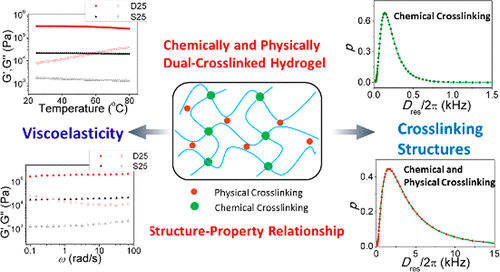当前位置:
X-MOL 学术
›
Macromolecules
›
论文详情
Our official English website, www.x-mol.net, welcomes your
feedback! (Note: you will need to create a separate account there.)
Viscoelasticity and Structures in Chemically and Physically Dual-Cross-Linked Hydrogels: Insights from Rheology and Proton Multiple-Quantum NMR Spectroscopy
Macromolecules ( IF 5.1 ) Pub Date : 2017-11-17 00:00:00 , DOI: 10.1021/acs.macromol.7b01854 Xueting Zou 1 , Xing Kui 2 , Rongchun Zhang 3 , Yue Zhang 2 , Xiaoliang Wang 2 , Qiang Wu 1 , Tiehong Chen 4, 5 , Pingchuan Sun 1, 3, 5
Macromolecules ( IF 5.1 ) Pub Date : 2017-11-17 00:00:00 , DOI: 10.1021/acs.macromol.7b01854 Xueting Zou 1 , Xing Kui 2 , Rongchun Zhang 3 , Yue Zhang 2 , Xiaoliang Wang 2 , Qiang Wu 1 , Tiehong Chen 4, 5 , Pingchuan Sun 1, 3, 5
Affiliation

|
Hydrogels have received considerable attention as an innovative material due to their widespread applications in various fields. As a soft and wet material, its mechanical behavior is best understood in terms of the viscoelastic response to the periodic deformation, which is closely related to the microscopic chemically/physically cross-linked structures. Herein, a dual-cross-linked (DC) hydrogel, where a physically cross-linked network by ionic coordination (Fe3+) is imposed on a chemically cross-linked poly(acrylamide-co-acrylic acid) network, was studied in detail by rheology and proton multiple-quantum (MQ) NMR spectroscopy. Rheology experiments revealed the diverse temperature- and strain-frequency-dependent viscoelastic behaviors for DC hydrogels induced by the dynamic Fe3+ coordination interactions, in contrast to the single chemically cross-linked (SC) hydrogels. During the shear experiment, the trivalent Fe3+ complex with moderate/weak binding strength might transform to those with strong binding strength and serve as permanent-like cross-linkages to resist the periodic deformation when a large strain frequency was applied. The viscoelastic behaviors of the DC hydrogels were strongly affected by the monomer ratio (CAAc/CAAm) and Fe3+ concentrations; however, the chemically cross-linked density did not change with CAAc/CAAm, while the physically cross-linked density was greatly enhanced with increasing Fe3+ concentrations. Besides, the DC hydrogels have less contents of network defects in comparison to the SC hydrogels. The heterogeneous structural evolution with increasing the Fe3+ concentration and monomer ratio was also quantitatively determined and elucidated by proton MQ NMR spectroscopy. In addition, the moduli (G′, G″) of DC hydrogels were almost an order magnitude higher than that of the corresponding SC hydrogels, demonstrating the significant contribution of Fe3+ coordination to the mechanical properties, in consistent with the high activation energy of viscoelasticity for the physically cross-linked network as obtained from the variable-temperature shear rheology experiments. The experimental findings obtained from the rheology and proton MQ NMR experiments can be correlated with and complementary to each other. Herein, a combination of rheology and proton solid-state NMR is well demonstrated as an effective and unique way for establishing the relationship between microscopic structures and macroscopic viscoelastic properties.
中文翻译:

化学和物理双交联水凝胶中的粘弹性和结构:流变学和质子多量子核磁共振波谱的见解。
水凝胶由于其在各个领域的广泛应用而作为创新材料受到了广泛的关注。作为一种柔软的湿材料,可以通过对周期性变形的粘弹性响应来最好地了解其机械性能,这种变形与微观的化学/物理交联结构密切相关。本文中,研究了一种双交联(DC)水凝胶,其中通过离子配位(Fe 3+)物理交联的网络被施加到化学交联的聚(丙烯酰胺-共-丙烯酸)网络上。流变学和质子多量子(MQ)NMR光谱学的详细信息。流变学实验表明,动态铁诱导的直流水凝胶具有多种温度和应变频率相关的粘弹性行为。与单一化学交联(SC)水凝胶相比,具有3+配位相互作用。在剪切实验中,具有中等/弱结合强度的三价Fe 3+络合物可能会转变为具有强结合强度的三价Fe 3+络合物,并在施加大应变频率时起永久性交联的作用,以抵抗周期性变形。DC水凝胶的粘弹性行为受单体比(C AAc / C AAm)和Fe 3+浓度的强烈影响。但是,化学交联密度并没有随C AAc / C AAm的变化而变化,而物理交联密度随Fe 3+浓度的增加而大大提高。此外,与SC水凝胶相比,DC水凝胶具有较少的网络缺陷含量。还通过质子MQ NMR光谱法定量确定并阐明了随着Fe 3+浓度和单体比例的增加而发生的异质结构演变。此外,模量(G ^ ',G ^ “)DC水凝胶的几乎比相应的SC水凝胶的数量级更高,这表明Fe的显著贡献3+协调机械性能,与从可变温度剪切流变学实验中获得的物理交联网络的高粘弹性活化能相一致。从流变学和质子MQ NMR实验获得的实验结果可以相互关联和互补。在本文中,流变学和质子固态NMR的结合已被证明是建立微观结构与宏观粘弹性之间关系的有效且独特的方法。
更新日期:2017-11-17
中文翻译:

化学和物理双交联水凝胶中的粘弹性和结构:流变学和质子多量子核磁共振波谱的见解。
水凝胶由于其在各个领域的广泛应用而作为创新材料受到了广泛的关注。作为一种柔软的湿材料,可以通过对周期性变形的粘弹性响应来最好地了解其机械性能,这种变形与微观的化学/物理交联结构密切相关。本文中,研究了一种双交联(DC)水凝胶,其中通过离子配位(Fe 3+)物理交联的网络被施加到化学交联的聚(丙烯酰胺-共-丙烯酸)网络上。流变学和质子多量子(MQ)NMR光谱学的详细信息。流变学实验表明,动态铁诱导的直流水凝胶具有多种温度和应变频率相关的粘弹性行为。与单一化学交联(SC)水凝胶相比,具有3+配位相互作用。在剪切实验中,具有中等/弱结合强度的三价Fe 3+络合物可能会转变为具有强结合强度的三价Fe 3+络合物,并在施加大应变频率时起永久性交联的作用,以抵抗周期性变形。DC水凝胶的粘弹性行为受单体比(C AAc / C AAm)和Fe 3+浓度的强烈影响。但是,化学交联密度并没有随C AAc / C AAm的变化而变化,而物理交联密度随Fe 3+浓度的增加而大大提高。此外,与SC水凝胶相比,DC水凝胶具有较少的网络缺陷含量。还通过质子MQ NMR光谱法定量确定并阐明了随着Fe 3+浓度和单体比例的增加而发生的异质结构演变。此外,模量(G ^ ',G ^ “)DC水凝胶的几乎比相应的SC水凝胶的数量级更高,这表明Fe的显著贡献3+协调机械性能,与从可变温度剪切流变学实验中获得的物理交联网络的高粘弹性活化能相一致。从流变学和质子MQ NMR实验获得的实验结果可以相互关联和互补。在本文中,流变学和质子固态NMR的结合已被证明是建立微观结构与宏观粘弹性之间关系的有效且独特的方法。










































 京公网安备 11010802027423号
京公网安备 11010802027423号